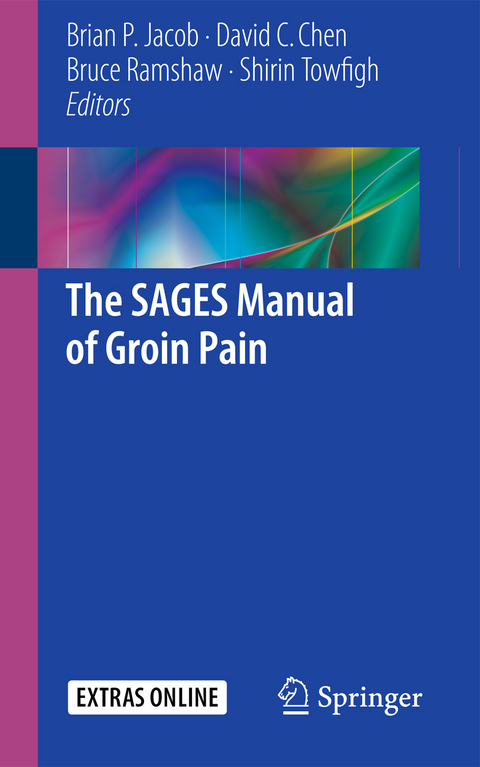
The SAGES Manual of Groin Pain
Springer International Publishing (Verlag)
978-3-319-21586-0 (ISBN)
This manual captures and summarizes the key elements in management of groin pain, including relevant anatomy, etiologies, diagnostic evaluation tools, imaging, detailed pharmacologic options, interventional modalities and options for operative remediation. The manual separately addresses the management of intrinsic groin pain due to primary disease processes and secondary groin pain due to a prior operation. Current practices, trends in the field, treatment approaches and controversies are addressed. While the primary audience of this book will be general surgeons performing hernia operations and pain management specialists to whom they refer, the SAGES Manual of Groin Pain will serve as a stand alone state-of-the-art resource for all providers who deal with this diagnosis, including primary care providers, sports medicine specialists, gynecologists, urologists, orthopedists, neurologists, physical medicine and rehabilitation specialists, radiologists, physical therapists, industry personnel and importantly, patients who suffer from groin pain who have copious access to health information, but without the filtering, expertise and context provided by the contributors to this manual.
This volume also uniquely provides its audience with narrative first-person accounts of some of the most common and challenging causes of pain, so that others can learn from their presentation, pitfalls, successes and failures. The expertise compiled in this manual will give the readership a pragmatic foundation to optimize the diagnosis and management of our patients with this challenging problem.
Brian P Jacob, MD, FACS Associate Clinical Professor of Surgery, Icahn School of Medicine at Mount Sinai;Partner, Laparoscopic Surgical Center of New York; Regional Medical Director (New York) AngelMD; Founder, International Hernia Collaboration, Inc., New York, New York David C. Chen, MD Associate Professor of Clinical Surgery; Clinical Director, Lichtenstein Amid Hernia Clinic, Department of Surgery, David Geffen School of Medicine at UCLA, Santa Monica, California Bruce Ramshaw, MD, FACS Co-Director, Advanced Hernia Solutions at Transformative Care Institute; Chief Medical Officer, Surgical Momentum; Chairman, the Bruce Kennedy General Surgery Residency Program at Halifax Health; Associate Clinical Professor, Florida State University, Daytona Beach, Florida Shirin Towfigh, MD, FACS President, Beverly Hills Hernia Center, Beverly Hills, California
Primary Groin Pain.- Musculoskeletal anatomy of groin pain.- Neuroanatomy of groin pain.- History: High yield questions to the patient as part of the history/intake.- Physical Examination: Highly sensitive and specific exam findings.- Inguinal Hernia, Femoral Hernia.- Non-Hernia Causes: Adductor Tendinitis, Osteitis Pubis, Epididymitis, Varicocele, Referred Pain (from hip (e.g., labral tear), back (e.g., radiculopathy, sacroiliitis, ankylosing spondylitis)).- Sports Hernia.- Chronic pelvic pain in women (endometriosis, pelvic floor dysfunction, round ligament syndrome or masses, ovarian cyst disease, occult hernias).- Occult Hernias: Typical presentation, symptoms, exam findings, radiologic evaluation.- Secondary Groin Pain.- Causes of Pain from Anterior Repair.- Causes of Pain from Posterior Repair.- Algorithm for Pain Management.- Pharmacologic Management.- Interventional Procedures: Nerve block, epidurals, ablation, neurostimulators.- Radiologic findings of mesh and meshoma.- Dermatomal Mapping: Pre/post-operative assessment.- Quantitative Sensory Testing (QST).- Management of Recurrence.- Open Triple Neurectomy vs selective neurectomy.- Laparoscopic Triple Neurectomy.- Meshoma Removal (Lap and open).- Treatment of Orchialgia.- Selected Topics.- Prevention of Pain: Open Technique (include mesh-specific tips).- Prevention of Pain: Laparoscopic Technique (include technical tips).- Prophylactic Neurectomy versus Pragmatic Neurectomy.- Selective Neurectomy versus Triple Neurectomy.- Patient Narratives.- Emerging patient and provider care communities (social media for patients with groin pain and for providers who care for patients with groin pain).- Value-based clinical quality improvement- learning to improve the value of treating patients with groin pain.- Team based approach for treating patients with chronic groin pain.
"This addition to the SAGES Manual series covers in exhaustive detail the evaluation, differential diagnosis, and management of groin pain. ... The audience includes a wide variety of practitioners: surgeons and physicians in other specialties including sports medicine and physical medicine and rehabilitation. ... This is a much-needed resource. ... No other book brings the full spectrum of diagnostic possibilities and therapeutic options together so well. ... This book deserves to become a classic in the field." (Carol Scott-Conner, Doody's Book Reviews, April, 2016)
| Erscheint lt. Verlag | 18.12.2015 |
|---|---|
| Zusatzinfo | XX, 546 p. 128 illus., 116 illus. in color. |
| Verlagsort | Cham |
| Sprache | englisch |
| Maße | 127 x 203 mm |
| Themenwelt | Medizin / Pharmazie ► Gesundheitswesen |
| Medizin / Pharmazie ► Medizinische Fachgebiete ► Chirurgie | |
| Medizin / Pharmazie ► Medizinische Fachgebiete ► Schmerztherapie | |
| Schlagworte | Adductor Tendinitis • Epididymitis • Femoral Hernia • Inguinal Hernia • Osteitis Pubis • varicocele |
| ISBN-10 | 3-319-21586-8 / 3319215868 |
| ISBN-13 | 978-3-319-21586-0 / 9783319215860 |
| Zustand | Neuware |
| Haben Sie eine Frage zum Produkt? |
aus dem Bereich


